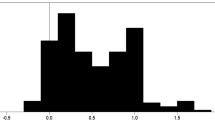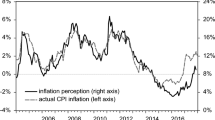Abstract
The euro illusion is a transient phenomenon that consists of currency-related asymmetries in the intuitive judgment of product prices made by consumers. The results of a cross-country study in the third year after the introduction of the euro show a strong price estimation asymmetry in a country with an extreme exchange rate (Italy) and a weaker effect in a country in which the nominal values of the new and the old currency are much closer (Ireland). These results rule out proposed explanations of the euro illusion in price estimation that assume the sole influence of plausible anchors (reference prices stored in memory within the plausible price range), supporting instead accounts also endorsing the role of implausible anchors (reference prices outside the plausible price range). Beyond contributing to our theoretical understanding of the euro illusion, this research starts to unveil the interplay between structural factors (i.e., the currency exchange rate) and psychological mechanisms that produce long-lasting difficulties for consumers after a monetary changeover.
Similar content being viewed by others
Notes
The prices and the frequency of purchase of the products and their range of variation were checked using a number of sources, for the prices the following: (a) the stores where the data collection was to be carried out; (b) the web sites of the main national supermarket chains (e.g., the e-coop web site in Italy – www.e-coop.it – and the Tesco web site in Ireland – www.tesco.ie ); (c) web sites that present a great number of products with different price ranges (e.g., amazon.com, bizrate.com) or national web services (shopbots) that are specifically devoted to price comparisons (e.g., trovaprezzi.it); and for the frequencies of purchase the following: (a) the information provided by the national statistical agencies www.istat.it, www.cso.ie ), and in particular surveys on the shopping habits of consumers; (b) previous studies on adaptation to the Euro.
All the data analyses were performed after the removal of outliers and extreme data points on a variable-by-variable basis.
References
Aalto-Setälä, V., & Raijas, A. (2003). Consumer price knowledge before and after the changeover. International Journal of Consumer Studies, 27, 210–217.
Amado, S., Teközel, M., Topsever, Y., Ranyard, R., Del Missier, F., & Bonini, N. (2007). Does “000,000” matter? Psychological effects of Turkish monetary reform. Journal of Economic Psychology, 28, 154–169.
Burgoyne, C. B., Routh, D. A., & Ellis, A. (1999). The transition to the Euro: Perspectives from economic psychology. Journal of Consumer Policy, 22, 91–116.
Dehaene, S., & Marques, J. F. (2002). Cognitive euroscience: Scalar variability in price estimation and the cognitive consequences of switching to the euro. Quarterly Journal of Experimental Psychology: Human Experimental Psychology, 55, 705–731.
Del Giovane, P., Lippi., F., & Sabbatini, R. (2005). L’euro e l’inflazione. Bologna: Il Mulino.
European Commission (2002). Flash EB 139. The Euro, 1 year later. Retrieved from http://ec.europa.eu/public_opinion/archives/flash_arch_en.htm.
European Commission (2003). Flash EB 153. The Euro, 2 years later. Retrieved from http://ec.europa.eu/public_opinion/archives/flash_arch_en.htm.
European Commission (2004). Flash EB 165. The Euro, 3 years later. Retrieved from http://ec.europa.eu/public_opinion/archives/flash_arch_en.htm.
European Commission (2005). Flash EB 175. The euro, 4 years after the introduction of the banknotes and coins. Retrieved from http://ec.europa.eu/public_opinion/archives/flash_arch_en.htm.
Gamble, A. (2007). The euro illusion: Illusion or fact? Journal of Consumer Policy, 30(4), (in press). DOI 10.1007/s10603-007-9044-3.
Gamble, A., Gärling, T., Charlton, J., & Ranyard, R. (2002). Euro illusion: Psychological insights into price evaluations with the unitary currency. European Psychologist, 7, 302–311.
Gamble, A., Gärling, T., Västfjäll, D., & Marell, A., (2005). Interaction effects of mood induction and nominal representation of price on consumer choice. Journal of Retailing and Consumer Services, 12, 397–406.
Jonas, E., Greitemeyer, T., Frey, D., & Schulz-Hardt, S. (2002). Psychological effects of the Euro-experimental research on the perception of salaries and price estimations. European Journal of Social Psychology, 32, 147–169
Juliusson, E. A., Gamble, A., & Gärling, T. (2005). Learning the value of a new currency from prices. Journal of Experimental Psychology: Applied, 11, 45–52.
Kopalle, P. K., Rao, A. G., & Assunção, J. L. (1996). Asymmetric reference price effects and dynamic pricing policies. Marketing Science, 15, 60–85.
Lambkin, M. (2001). Attitudes towards European Monetary Union in Ireland. In A. Müller-Peters, R. Pepermans, G. Kiell, & M. Farhangmehr (Eds.), The Psychology of European Monetary Union: A cross-national study of public opinion towards the Euro (pp. 285–298). Santiago de Compostela: Compostela Group of Universities.
Lemaire, P. (2007). The impact of the Euro changeover on between-currency conversions. Journal of Consumer Policy, 30(4), (in press). DOI 10.1007/s10603-007-9045-2.
Lemaire, P., & Lecacheur, M. (2001). Older and younger adult’s strategy use in currency conversion tasks: Insights from French franc to Euro and Euro to French franc conversion. Journal of Experimental Psychology: Applied, 3, 195–206.
Lemaire, P., Lecacheur, M., & Ferréol Barbey, M. (2001). Strategy use in currency conversion tasks: The examples of Euro to French franc to Euro conversions. Current Psychology Letters, 4, 39–50.
Marques, J. F. (1999). Changing “EUROpe” – The Euro as a new subject for psychological research in numerical cognition. European Psychologist, 4, 152–156.
Marques, J. F. (2007). The euro changeover and numerical intuition for prices in the old and new currencies. Journal of Consumer Policy, 30(4), (in press). DOI 10.1007/s10603-007-9043-4.
Marques, J. F., & Dehaene, S. (2004). Developing intuition for prices in euros: Rescaling or relearning prices? Journal of Experimental Psychology: Applied, 10, 148–155.
Mussweiler, T., & Englich, B. (2003). Adapting to the Euro: Evidence from bias reduction. Journal of Economic Psychology, 24, 285–292.
Mussweiler, T., & Strack, F. (1999). Comparing is believing: A selective accessibility model of judgmental anchoring. In W. Stroebe, & M. Hewstone (Eds.), European review of social psychology (pp. 135–168). Chichester: Wiley.
Mussweiler, T., & Strack, F. (2000). Numeric judgments under uncertainty: The role of knowledge in anchoring. Journal of Experimental Social Psychology, 36, 495–518.
Mussweiler, T., & Strack, F. (2001). Considering the impossible: Explaining the effects of implausible anchors. Social Cognition, 19, 145–160.
Niedrich, R. N., Sharma, S., & Wedell, D. H. (2001). Reference price and price perception: A comparison of alternative models. Journal of Consumer Research, 28, 339–354.
Przybyszewski, K., & Tyszka, T. (2007). Emotional factors in currency perception. Journal of Consumer Policy, 30(4), (in press).
Raghubir, P. & Srivastava, J. (2002).Effect of face value on product valuation in foreign currencies. Journal of Consumer Research, 29, 335–347.
Ranyard, R., Charlton, J. P., & Williamson, J. (2001). The role of internal reference prices in consumers willingness to pay judgments: Thaler’s Beer Pricing Task revisited. Acta Psychologica, 106, 265–283.
Ranyard, R., Routh, D. A., Burgoyne, C., Saldanha, G. (2007). A qualitative study of adaptation to the Euro in the republic of Ireland: 2. Errors, learning, and the role of currency conversion. European Psychologist, (in press).
Soman, D., Wertenbroch, K., & Chattopadhyay, A. (2002). “Currency numerosity effects on the perceived value of transaction”. INSEAD Working Paper Series, 2002, 124/MKT.
Traut-Mattausch, E., Greitemeyer, T., Frey, D., & Schulz-Hardt, S. (2007). Expectancy-consistent judgment bias in spite of unequivocal contradictory evidence: Findings from a research program on illusory price increases due to the introduction of the Euro. Journal of Consumer Policy, 30(4), (in press).
Tyszka, T., & Przybyszewski, K. (2006). Cognitive and emotional factors affecting currency perception. Journal of Economic Psychology, 27, 518–530.
Van Raaij, W. F., & Van Rijen, C. L. A. (2003). Money illusion and Euro pricing. IAREP Workshop ‘Euro: currency and symbol’. University of Vienna, Austria, July 3–5.
Acknowledgements
This research was funded by Consiglio Nazionale delle Ricerche through a grant awarded to Nicolao Bonini for the European project Adapting to the Euro: A cross-national comparison of the evaluation of Euro price changes (European Research Collaborative Program on the Social Sciences).
Thanks are due to Mary Lambkin and Laurent Muzellec (University College Dublin) for having supervised and managed the Irish data collection, and to Sara Franzo for her help with the Italian data collection.
Author information
Authors and Affiliations
Corresponding author
Appendices
Appendix A: Descriptions of the Products Used in the Price Estimation Study
-
PRODUCT: 1 packet of 80 tea bags (250 gr/0.55 lb)
-
–1 litre (1.8 pints) of orange juice
-
–1 jar of paprika (34 gr/1.19 oz)
-
–1 kg (2.2 lb) of white potatoes (bag)
-
–1 drawing compass
-
–1 packet of pasta (spaghetti) 500 gr (1.1 lb)
-
–1 pair of office scissors: 16 cm (6 inches), stainless steel with blunt tips
-
–1 DVD player
-
–1 wardrobe with three doors
-
–1 dental polishing (private dentist)
-
–Compact car: New, 998 cm3 engine, three doors
-
–3 star hotel in a tourist beach destination: one night and breakfast in July
-
–1 ticket for a flight Dublin [Venice] – New York: no connections, roundtrip, economy class, August
Appendix B: Questions About Currency Conversion, Eurobarometer Questions, and Attitude-related Questions
Eurobarometer Questions
-
–Today, would you say that the euro continues to cause you a lot of difficulty, some difficulty or no difficulty at all? (a lot of difficulty – some difficulty – no difficulty)
-
–Today, when purchasing, do you count mentally most often in euro, most often in punt [lira], or as often in euro as in punt [lira] when it concerns exceptional purchases such as the purchase of a car or a house for example? (most often in euro – most often in punt [lira] – as often in euro as in punt [Lira])
-
–Today, when purchasing, do you count mentally most often in euro, most often in punt [lira], or as often in euro as in punt [Lira] when it concerns common purchases such as day to day shopping? (most often in euro – most often in punt [lira] – as often in euro as in punt [lira])
Questions About Currency Conversion and Adaptation
-
–How often do you convert the price of a product in punt [lire] in order to understand how expensive is it? (Never – Seldom – Sometimes – Frequently – Always)
-
–How difficult was your adaptation to the euro? (Very Difficult – Difficult – Not difficult nor easy – Easy – Very easy – Don’t know)
Attitude-related Questions
-
–Think about the European Union. Generally speaking, do you think that Ireland’s [Italy’s] membership of the European Union is ... (Very negative – Negative – Not negative nor positive – Positive – Very Positive – Don’t know)
-
–Are you for or against the European Union having the euro as the single currency in all member states, including Ireland [Italy]? (Very Unfavorable – Unfavorable – Not unfavorable nor favorable – Favorable – Very Favorable – Don’t know)
-
–How important is the single European currency to you personally? (Very Unimportant – Unimportant – Not unimportant nor important – Important – Very Important – Don’t know)
-
–Do you believe that goods had become less or more expensive with the new currency? (Much less expensive – Less expensive – Not less expensive nor more expensive – More expensive – Much more expensive – Don’t know)
Rights and permissions
About this article
Cite this article
Del Missier, F., Bonini, N. & Ranyard, R. The Euro Illusion in Consumers’ Price Estimation: An Italian–Irish Comparison in the Third Year of the Euro. J Consum Policy 30, 337–354 (2007). https://doi.org/10.1007/s10603-007-9041-6
Received:
Accepted:
Published:
Issue Date:
DOI: https://doi.org/10.1007/s10603-007-9041-6
Keywords
- Price estimation
- Euro illusion
- Currency change
- Adaptation
- Anchoring and adjustment
- Reference price
- Cross-country comparison




